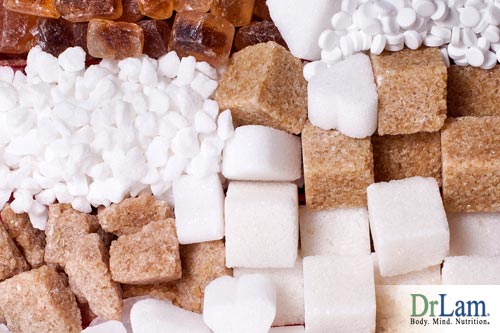 In this article, you will learn how sugar and aging are related, how sugar and aging prematurely can reduce your quality of life, and ways in which to improve your health as related to sugar and aging. Common table sugar represents about 20 to 25 percent of the daily caloric intake of the average American. This translates into the equivalent of half a pound a day and over 5 tons in a lifetime. In the early 1800's, the average sugar consumption was 12 pounds per person annually. This increased to 124 pounds in 1980 and to 152 pounds in 1997. It is estimated that 75 percent of all sugar we consume comes from processed food.Studies have linked a high sugar intake with an increased risk of diabetes, cardiovascular disease, and cancer. Researchers have found strong links between sugar and aging prematurely as well. Is this pure coincidence, or is the association real? Keep reading to learn more about sugar and aging.
In this article, you will learn how sugar and aging are related, how sugar and aging prematurely can reduce your quality of life, and ways in which to improve your health as related to sugar and aging. Common table sugar represents about 20 to 25 percent of the daily caloric intake of the average American. This translates into the equivalent of half a pound a day and over 5 tons in a lifetime. In the early 1800's, the average sugar consumption was 12 pounds per person annually. This increased to 124 pounds in 1980 and to 152 pounds in 1997. It is estimated that 75 percent of all sugar we consume comes from processed food.Studies have linked a high sugar intake with an increased risk of diabetes, cardiovascular disease, and cancer. Researchers have found strong links between sugar and aging prematurely as well. Is this pure coincidence, or is the association real? Keep reading to learn more about sugar and aging.
So how do sugar and aging prematurely interact? Sugar is a generic term used to identify simple forms of carbohydrates, which includes fructose, glucose, galactose, maltose and sucrose (white table sugar). The type of sugar and its rate of breakdown can affect the body greatly. For example, table sugar is considered nutritive as it contains calories, although it does not contain vitamins, minerals or fiber. Another sugar type known as glucose has the ability to break down quickly in the stomach and later be pumped across the intestinal wall directly into the bloodstream. This process rapidly raises blood-glucose levels, which causes the blood sugar level to spike. On the other hand, fructose, which is sugar derived from fruits, gets into the body and is slowly absorbed in the gut. It is then converted to glucose in the liver. This makes fructose a "time-release food" as it delivers calories at a gradual rate. So what does all of this have to do with sugar and aging? Well, a complete understanding of sugars and how they affect our body is critical to the study of sugar and aging processes and disorders.
Carbs and sugars and aging come together in many ways. Carbohydrates are merely different forms of sugars linked together in polymers. Most people will consider sweets and pasta as carbohydrates. Most are not aware that fruits and vegetables are also considered carbohydrates as well. In reality, sugar, sweets, pasta, vegetables, and fruits are all carbohydrates. But, it is not all bad sugar and aging prematurely isn't necessarily caused by fruits and vegetables.
This confusion is compounded when one considers that a carbohydrate diet consisting mainly of green leafy vegetables is good for anti-aging. On the other hand, a carbohydrate diet consisting primarily of white rice, potato, pasta, cakes, ice cream, and bread is a negative fountain of youth.
While both "good and bad" carbohydrates are classified in the same general group, the effects on the body are totally different. To put matters into proper prospective, any discussion on carbohydrates must clearly address the specific kinds of carbohydrates in question.
Starches and sugar and aging are associated with one another because starches are the most basic form of carbohydrates. It is found in all fruits, vegetables, grains and legumes. Starch is broken down in our digestive tract into small molecules of glucose, which are then absorbed and transported into cells for energy production.
Many fruits and some vegetables contain significant amounts of glucose and fructose, as well as a disaccharide called sucrose (ordinary sugar), which contains both glucose and fructose.
Our bodies have been accustomed to metabolizing about 300 grams of glucose (mostly from starchy foods) every day for thousands of years.
 We have always consumed some fructose, often in the form of fruits and honey. Until about 200 years ago, the average daily intake of fructose was only eight grams a day. As ordinary sugar (sucrose) from sugar beets and sugar cane began to be readily available, the daily intake of fructose raised 10 fold to 75 grams a day. The problem is further compounded since the 1970s, when high fructose corn syrup was introduced as a substitute sweetener. About 9% of the average dietary calorie intake now comes from fructose.
We have always consumed some fructose, often in the form of fruits and honey. Until about 200 years ago, the average daily intake of fructose was only eight grams a day. As ordinary sugar (sucrose) from sugar beets and sugar cane began to be readily available, the daily intake of fructose raised 10 fold to 75 grams a day. The problem is further compounded since the 1970s, when high fructose corn syrup was introduced as a substitute sweetener. About 9% of the average dietary calorie intake now comes from fructose.
When sucrose is ingested, it reacts with water to generate glucose and fructose in equal amounts. Each 100 grams of sucrose produces 53 grams of glucose and 53 grams of fructose. Sucrose is called a disaccharide for this reason. The ingestion of 100 pounds of sugar (sucrose) per year translates into 125 grams per day and 66 grams of fructose. With about 8 grams added on from fruits and honey, the total average intake per day now becomes 74 grams. Our body is used to metabolizing only eight grams of fructose a day. The nearly 10-fold overload has caused many health problems, which we will discuss below. Keep reading to discover more about how sugar and aging are related.
Carbohydrates break down into glucose, which is the primary fuel the body needs to keep it operationally functional. Certain organs require more fuel than others to run. The brain utilizes almost two thirds of the circulating carbohydrates in the bloodstream to keep it functioning.
Any excess carbohydrates not needed are stored as glycogen (a storage form of glucose). Glycogen is stored in the liver and the muscles. When the brain needs fuel, the glycogen in the liver is broken down and transported to the brain for energy.
How much carbohydrate can you store? The total storage capacity of the body for carbohydrates is limited. An average person stores about 300 to 400 grams of carbohydrates in the muscles, which cannot be utilized by the brain for energy. Only 60 to 90 grams are stored in the liver for glucose conversion, equivalent to about two cups of cooked pasta or three typical candy bars. This is all the body has in reserve to keep the brain working properly.
Once the glycogen levels are filled in both the liver and the muscles, excess carbohydrates are converted into fat and stored in the adipose tissue. Hence, excess carbohydrates become fat. In modern day society, it is sugar that makes a person fat much more that the amount of fat a person consumes. Continue to read to learn more about what your body needs to counteract sugar and aging prematurely.
The key function of carbohydrates is to provide energy for the body. Julius Robert Mayer, a German physician, initially discovered the concept of food energy in 1842. The energy values of a food can be determined by burning a set amount of food and measuring the amount of heat produced. The common energy value is expressed in kilocalorie and is based on the burning of 100 grams (or 3.5 ounces) of the food. It is determined that approximately 900 kcal is generated per 100 gram of fat and 400 kcal per 100 gram of carbohydrate and protein intake.
 There are only four macronutrients we consume on a daily basis - water, fat, protein, and carbohydrates. Out of these, only carbohydrates are nonessential to the human diet. One can survive for long periods of time without carbohydrates provided that protein and fat needs are met, for these two are ultimately broken down to form building blocks of carbohydrates as food energy for the body.
There are only four macronutrients we consume on a daily basis - water, fat, protein, and carbohydrates. Out of these, only carbohydrates are nonessential to the human diet. One can survive for long periods of time without carbohydrates provided that protein and fat needs are met, for these two are ultimately broken down to form building blocks of carbohydrates as food energy for the body.
An intake of 300 grams of carbohydrates yielding 1,200 kcal would provide 50 percent of an average daily requirement of energy in an average American diet. A 2,500-calorie diet with 20 percent of energy provided by protein (about four ounces or 120 grams) will generate about 500 calories of energy. The amount of protein needed to sustain normal bodily function can be readily supplied in four ounces of meat. The average American consumes more protein than is needed.
There are three common ways to classify carbohydrates:
All carbohydrates are broken down into sugar inside the body. It is the rate and the amount of this dissolution that determines the level of sugar in the blood. Complex carbohydrates such as green leafy vegetables, brown rice, potato, whole grain products, legumes, and fruits break down slowly, thus causing a gradual rise and fall in blood sugar. Generally speaking, most complex carbohydrates are considered good for health.
On the other hand, simple carbohydrates such as cakes, white rice, and ice cream break down quickly once inside the body. This causes rapid spikes in blood sugar levels and subsequent valleys when the sugar is absorbed. Most simple carbohydrates are detrimental to our health. These are related to suagar and aging prematurely.
This simple and easily comprehensive classification of carbohydrates is however incomplete. While most simple carbohydrates are harmful, some complex carbohydrates, such as potato starch, is also not good for health because of their relatively fast rate of breakdown.
Another way of looking at carbohydrates is to return to the principles of the "evolutionary diet." The author and champion of the "Paleolithic diet", Robert Crayhon, M.S., divided carbohydrates into two basic groups, paleocarbs and neocarbs.
Paleocarbs are carbohydrates that have existed since the beginning of time. They include fruits, seeds, and vegetables that primarily grow above the ground. Generally speaking, these are "good" carbohydrates as they provide the body with needed antioxidants, fiber, nutrients, and calories in a slow-release fashion.
Neocarbs are carbohydrates introduced within the last 10,000 years when modern agriculture first started. These include grains, legumes and flour products. Some neocarbs like legumes are grown above the ground and are nutritious. Others are grown under the ground. These include potato, yam and carrots, which are high in sugar and therefore not optimum for health.
Other neocarbs, like rice and flour, while grown above the ground, are refined and converted into sugar quickly once inside our body. Neocarbs are generally considered negative for aging.
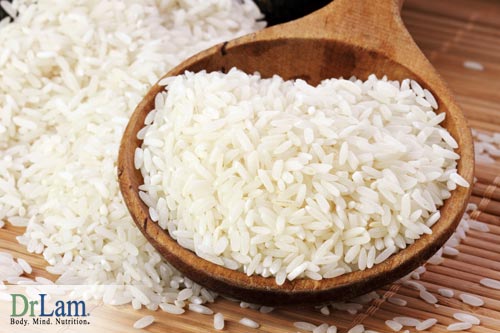 As early humans were hunters, it is estimated that as much as 65 percent of calories from the diet were derived from animal products such as lean meat and fat. Agriculture was only started about 8,000 to10, 000 years ago. The modern day diet, which consists of a constant supply of highly refined simple carbohydrates (neocarbs), has resulted in postprandial hyperglycemia, hyperinsulinemia, and subsequent diseases including obesity, diabetes and cardiovascular disease.
As early humans were hunters, it is estimated that as much as 65 percent of calories from the diet were derived from animal products such as lean meat and fat. Agriculture was only started about 8,000 to10, 000 years ago. The modern day diet, which consists of a constant supply of highly refined simple carbohydrates (neocarbs), has resulted in postprandial hyperglycemia, hyperinsulinemia, and subsequent diseases including obesity, diabetes and cardiovascular disease.
A sensible diet should include lean meats, fish, seafood and complex paleocarbs such as green leafy vegetables, fruits, nuts and seeds. This is commonly termed as the evolutionary diet. Such a diet is consistent with the Mediterranean diet, which contains 60 percent carbohydrates, out of which paleocarbs should be the majority.
Another way to classify carbohydrates, and understand more about the relationship between sugar and aging, is the use of the glycemic index. This index is a measure of how a given food affects the blood-glucose levels. Each food is assigned a numbered rating. The index measures the entry rate of a carbohydrate into the bloodstream. The lower the rating, the slower the digestion and absorption process and the better it is for the body. This means a healthier and more gradual release of sugars into the bloodstream. Conversely, a high rating implies that blood-glucose levels are increased quickly, which stimulates the pancreas to secrete insulin to normalize blood-sugar levels. This rapid fluctuation of blood-sugar levels is unhealthy because of the amount of stress placed on the body.
The glycemic index of an individual carbohydrate serves only as a general guide. Nevertheless, this classification gives us a general understanding of which types of food breaks down faster and is, therefore, harmful to health. Similarly, the index also provides an indication of which kinds of foods break down slowly and are thus essential for anti-aging.
By using the glycemic index alone, one could misinterpret that a cup of low-fat ice cream is healthier than a baked potato. This is because the glycemic index of low fat ice cream (glycemic index of 50) is actually lower than that of a baked potato (glycemic index of 85). This is obviously an incorrect conclusion. Close scrutiny of the index is needed because the glycemic index rating of a sugary food is lower than that of a starchy food. The primary factors that determine the glycemic index are the structure of simple sugars in the food, soluble fiber content, fat content and the level of food processing.
Generally speaking however, selecting carbohydrates with a low to moderate glycemic index is an important part of an anti-aging program. The lower the index, the slower the rate of absorption.
Here is a glycemic index table of some common foods:
| Food | Glycemic Index |
|---|---|
| Glucose | 96 |
| Wheat bread, gluten free | 90 |
| Rice, Calrose | 87 |
| Potato, baked | 85 |
| Cheerios | 74 |
| Potato mashed | 70 |
| Soft drink, Fanta | 68 |
| Pizza, cheese | 60 |
| Sweet corn | 55 |
| Banana | 54 |
| Sweet potato | 54 |
| Ice cream, low fat | 50 |
| Carrots | 49 |
| Grapefruit juice | 48 |
| Grapes | 46 |
| All-bran | 42 |
| Spaghetti, white | 41 |
| Apple | 38 |
| Mars M&Ms (peanut) | 32 |
| Peanuts | 15 |
| Yogurt, low fat, artificially sweetened | 14 |
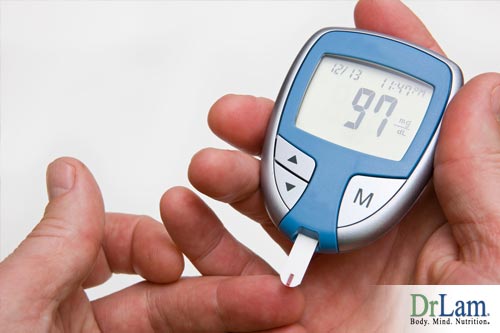 The 1997 American Diabetes Association considers the blood glucose level of 126 mg/dL or higher to be diabetic; 111?125 mg/dL as impaired glucose tolerance and levels less than 110 mg/dL to be normal. The paleolithic diet, which consisted of lean meats, vegetables (complex carbohydrates) and small amounts of whole grains, nuts, seeds and fruits, is estimated to have generated blood glucose levels between 60 and 90 mg/dL.
The 1997 American Diabetes Association considers the blood glucose level of 126 mg/dL or higher to be diabetic; 111?125 mg/dL as impaired glucose tolerance and levels less than 110 mg/dL to be normal. The paleolithic diet, which consisted of lean meats, vegetables (complex carbohydrates) and small amounts of whole grains, nuts, seeds and fruits, is estimated to have generated blood glucose levels between 60 and 90 mg/dL.
Following the mainstream range of "normal" blood sugar, one can easily be mislead into thinking that a blood sugar of 110 is acceptable while in reality, it is far from optimum.
One of the greatest challenges in anti-aging medicine is to reset laboratory reference levels to an anti-aging range. The current laboratory standard is established based on a pathological disease state and not on optimum health. What is "normal" under routine laboratory standards is therefore high for anti-aging purposes. For many laboratory test the threshold reference standard for "normal" needs to be lowered for those interested in anti-aging.
So what does all of this have to do with sugar and aging? Well, while it is fair to comment that most people with a fasting blood sugar level of under 120 mg/dl are generally non-diabetic, those interested in optimizing their health should consider maintaining a fasting sugar level of no higher than 90 mg/dl.
The effects of high blood sugar include:
A rise in sugar consumption over the last century has concurrently resulted in a rise in the incidence of Type 2 adult onset diabetes mellitus (AODM) or non-insulin dependent diabetes (NIDDM). By the year 2025, the number of people with diabetes mellitus is estimated to grow to 260 million, according to the World Health Organization (WHO). Diabetes is encoraged by excess sugar and aging is hastened by diabetes.
This type of diabetes that afflicts adults has risen 33 percent in the past decade alone. Three out of every 50 adults are now affected with the serious, but still curable, diet-linked condition, according to studies by the Centers for Disease Control and Prevention.
Diabetes is a disease resulting from insulin imbalance. The pancreas releases insulin as carbohydrates are ingested. Carbohydrates cause a rise in blood sugar. Insulin's job is to move the sugar from the blood stream into the cell for metabolism. Insulin also helps converts almost half of your dietary carbohydrates to fat for storage.
The higher the level of sugar intake, the harder the pancreas has to work to produce the insulin required to normalize the blood sugar. An overproduction of insulin leads to a decrease in the number of insulin receptors in the cell (with an accompanying decrease in the removal of insulin and glucose from the blood). This is known as insulin resistance. The blood sugar level remains high as a result and this is the hallmark of diabetes.
In a prospective study of 65,000 US women, researchers concluded that diets with a high glycemic index (such as wheat, rice, and potato) increase insulin demand and thus cause hyperinsulinemia among patients with AODM and normal subjects. Hyperinsulinemia can increase the risk as well as exacerbate AODM.
 Chronic hyperinsulinemia is a result of a high sugar intake. It is not only associated with AODM but also to a host of other medical conditions jointly known as Syndrome X, characterized by hypertriglyceridemia, obesity, hyperglycemia, and hypertension.
Chronic hyperinsulinemia is a result of a high sugar intake. It is not only associated with AODM but also to a host of other medical conditions jointly known as Syndrome X, characterized by hypertriglyceridemia, obesity, hyperglycemia, and hypertension.
As many as 80 percent of individuals with AODM also suffer from obesity. Obesity often precedes AODM and is now recognized as a major risk factor for AODM. It is also estimated that there is at least one undiagnosed case of AODM for every diagnosed case. While some forms of diabetes are hereditary, there is very little doubt that a direct relationship exists among the glycemic index, AODM, and obesity.
Insulin is also called the "hunger hormone". As the blood sugar level increases following a carbohydrate meal, the corresponding insulin level rises with the eventual lowering of the blood sugar level. When the blood sugar level drops, hunger is felt. This often occurs a few hours after the meal. Cravings for sweets frequently form part of this cycle, which can lead to snacking, often for more carbohydrates. If the cravings are not fulfilled, sensations such as hunger, dizziness, moodiness, and a state of "collapse" can result.
Furthermore, high insulin levels prohibit the release of serotonin, a neurotransmitter in the brain that informs the body to slow down eating. Without serotonin, there is a tendency to overeat, which then leads to a spiral of excessive sugar intake. A viscous cycle of hyper-insulinemia resulting in insulin resistance is set up. This in turn creates a "carbohydrate addict" whose craving for a higher sugar intake continues to increase.
The key to controlling diabetes is to reduce the blood sugar level without depriving the body of fuel. Refined sugars such as food items with a high glycemic index are extremely harmful to diabetes patients. In addition to restraining such carbohydrates, almost every successful diabetes management program incorporates weight management as a cornerstone of therapy.
A reduction in the total simple refined carbohydrate intake coupled with an increased total energy output through exercise is a powerful combination to combat diabetes. By moderating such refined carbohydrate intake, one can increase fat burning as an optimal and efficient source of almost unlimited energy. The key is to restrict the intake of refined flour and bread.
AODM patients, those with a family history of diabetes and the elderly who are deficient in antioxidant defense systems, could also derive benefits by using an appropriate intake of antioxidant supplements such as Vitamins C and E. Other nutritional supplements such as L-glutamine and taurine, which inhibit excessive fatty acid oxidation, can also be considered. Chromium supplementation has long been found to be useful for weight loss and blood sugar control. Lesser-known supplements such as ubiquinone and gymnema sylvestre have also been reported to be useful in the prevention and treatment of diabetes.
In summary, a successful program to keep blood sugar normalized therefore requires four pillars:
The message is clear - sugar promotes diabetes.
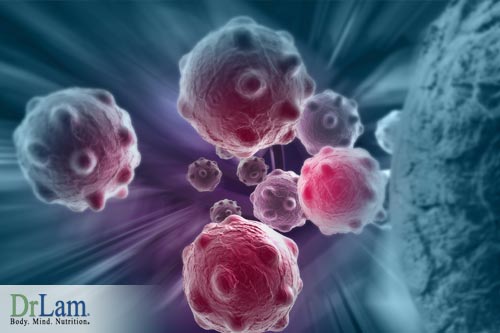 In 1931, the great Nobel laureate in medicine Otto Warburg, Ph.D. first discovered that cancer cells have a fundamentally and totally different energy metabolism compared to healthy cells. In his Nobel thesis, Dr. Warburg postulated that malignant tumors frequently exhibit an increase in anaerobic glycolysis - a process whereby glucose is used as a fuel by cancer cells with lactic acid as byproduct.
In 1931, the great Nobel laureate in medicine Otto Warburg, Ph.D. first discovered that cancer cells have a fundamentally and totally different energy metabolism compared to healthy cells. In his Nobel thesis, Dr. Warburg postulated that malignant tumors frequently exhibit an increase in anaerobic glycolysis - a process whereby glucose is used as a fuel by cancer cells with lactic acid as byproduct.
This is drastically different from normal tissues that use oxygen as the primary source of fuel. The large amount of lactic acid produced by this fermentation process of glucose from cancer cells is transported to the liver. The lactic acid generates a lower and more acidic pH in cancerous tissues as well as overall physical fatigue from lactic acid buildup. The patient therefore becomes tired easily.
Furthermore, this anaerobic (fermentation) pathway for energy metabolism in cancerous cells is highly inefficient. The chemical process of energy production by this pathway yields only two moles of adenosine triphosphate (ATP) energy per mole of glucose as compared to 38 moles of ATP in the complete aerobic oxidation of glucose in normal cells. By extracting only about five percent (two vs. 38 moles of ATP) of the available energy in the food supply and the body's caloric stores, the cancer is, in effect, "wasting" energy. Hence the patient becomes tired and undernourished. This vicious cycle increases body wasting. This is one reason why 40 percent of cancer patients die from malnutrition or cachexia.
Researchers support the concept of how "sugar feeds cancer". For example, a study using a mouse model of human breast cancer showed that tumors are quite sensitive to blood-glucose levels. Sixty-eight mice were injected with an aggressive strain of breast cancer. They were then fed diets to induce either high blood-sugar (hyperglycemia), normal, or low blood-sugar (hypoglycemia). There was a dose-dependent response. The lower the blood glucose level, the greater the survival rate. It was shown that after 70 days, eight of the 24 hyperglycemic mice survived compared to 16 of 24 normal glycemic and 19 of 20 hypoglycemic mice. This suggests that the restriction of sugar intake is the key to slowing the effects of breast tumors.
Internationally acclaimed Russian scientist Dr. Vladimir Dilman wrote in The Annals of the New York Academy of Science that breast cancer patients put out 22% more insulin than healthy controls; that colon cancer patients had 29% more triglyceride in their blood. Furthermore, epidemiological studies showed that patients with colon, renal, and endometrial cancers had over twice the chance of giving birth to high-birth-rate babies, one of the hallmarks of disturbed sugar metabolism.
An epidemiological study in 21 modern countries including Europe, North America, and Japan that keep track of morbidity and mortality revealed that sugar intake is a strong risk factor that contributes to higher breast cancer rates.
It is easy to overlook the important connection between sugar and its role in tumorgenesis in the clinical setting. The fact that tumor cells thrive on sugar has practical considerations. Consider the million-dollar positive emission tomography device, or PET scan, which is regarded as one of the ultimate cancer-detection tools. PET scans use radioactively labeled glucose to detect sugar-hungry tumor cells.
 A comprehensive cancer therapy program should therefore take into consideration a low sugar diet as part of the treatment protocol. A strict controlled supply of glucose, regarded as the cancer's preferred fuel, would slow down the effects of cancer. Some specialized cancer treatment centers in effect use this very concept by inducing a low blood sugar level for a short period of time to "starve" cancer cells without depriving the brain of the much needed sugar. Coupled with relevant therapies including chemotherapy, radiation, and surgery, tumor cells may be contained.
A comprehensive cancer therapy program should therefore take into consideration a low sugar diet as part of the treatment protocol. A strict controlled supply of glucose, regarded as the cancer's preferred fuel, would slow down the effects of cancer. Some specialized cancer treatment centers in effect use this very concept by inducing a low blood sugar level for a short period of time to "starve" cancer cells without depriving the brain of the much needed sugar. Coupled with relevant therapies including chemotherapy, radiation, and surgery, tumor cells may be contained.
The goal of a cancer prevention diet from a sugar perspective is to control blood glucose within a narrow range to help starve the cancer cells and bolster immune functions. Generally this means almost a 90% reduction in sugar intake.
The message is clear - sugar feeds cancer.
Many studies have shown that a direct correlation exists between sugar and free radical formation.
A study from the University at Buffalo, published in the Journal of Clinical Endocrinology and Metabolism in August 2000, showed that excess sugar in the bloodstream stimulates the production of free radicals. In this study, researchers gave 14 healthy men and women who had fasted for 12 hours a drink containing 75 grams of glucose. The sugar content is equivalent to that in two cans of soda. Researchers then took blood samples from all participants before the glucose challenge and again at various intervals thereafter.
There was no change in the free radical production in samples taken from controls. Subjects who drank the sugar water were found to have a significant increase in free radical production at one hour and more than doubled at two hours. At the same time, levels of alpha-tocopherol (vitamin E), a powerful antioxidant, fell about four percent by two hours and remained depressed at the third hour.
Diseases that result from free radicals include many age related illness such as atherosclerosis, dementia, cancer, arthritis, autoimmune disease, etc. Excess sugar generates free radicals indirectly. Excess sugar is converted into triglycerides and cholesterol in the liver. The excessive cholesterol and free fatty acid (FFA), when released in order to generate energy for the body, causes the production of free radical metabolites that inhibit glucose utilization by the muscle.
The message is clear - sugar increases free radicals and accelerates age related diseases.
So what does AGEs have to do with the realtionship between suagr and aging? The theory of advanced glycation end products (AGEs) concerning the relationship between sugar and aging processes dates back many years. It is commonly known that people with diabetes die prematurely. AGEs are substances formed when blood sugar (glucose) attaches itself to proteins in the body's tissues. This results in cross-linked hard yellow-brown AGE compounds. Negative effects of AGEs include thickened arteries, stiff joints, feeble muscles, and failing organs. This is especially evident in elderly people. Diabetics suffer a very high incidence of nerve, artery, and kidney damage because their high blood sugar levels greatly accelerate the chemical reactions that form AGEs.
The message is clear - sugar accelerates aging.
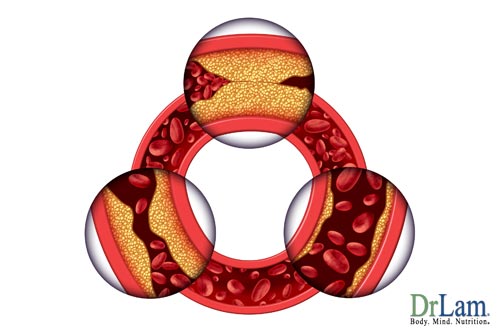 Incerases in heart disease represent signs of premature aging, so it is necessary to discuss such factors in a coversation concerning sugar and aging. Between 1910 and 1970, coronary heart disease escalated from a yet-to-be recognized problem to one of the most deadly diseases of the past century. Due to better consumer education, the intake of animal fat and butter dropped significantly while the intake of cholesterol remained unchanged in the past fifty years. The intake of refined carbohydrates (mainly sugar, fructose from corn syrup and white flour) however, increased significantly. The irony is that the increasing incidence of cardiovascular disease closely parallels the increasing consumption of sugar and not with the consumption of animal fat (saturated fat) or of total fat. Thus the finger is pointed even more directly to the close realtionship between suagr and aging rapidly in additon to the symptoms that are related to premature aging such as above.
Incerases in heart disease represent signs of premature aging, so it is necessary to discuss such factors in a coversation concerning sugar and aging. Between 1910 and 1970, coronary heart disease escalated from a yet-to-be recognized problem to one of the most deadly diseases of the past century. Due to better consumer education, the intake of animal fat and butter dropped significantly while the intake of cholesterol remained unchanged in the past fifty years. The intake of refined carbohydrates (mainly sugar, fructose from corn syrup and white flour) however, increased significantly. The irony is that the increasing incidence of cardiovascular disease closely parallels the increasing consumption of sugar and not with the consumption of animal fat (saturated fat) or of total fat. Thus the finger is pointed even more directly to the close realtionship between suagr and aging rapidly in additon to the symptoms that are related to premature aging such as above.
Studies in the past 30-40 years have shown that substituting saturated fat (animal fat) with polyunsaturated fats (such as vegetable oils) lowered serum total cholesterol levels. Clinical trials subsequently suggested that this dietary change might reduce the incidence of coronary heart disease. As a result, diets high in polyunsaturated fats were widely recommended for the prevention of coronary heart disease. Instead of fat, carbohydrate was promoted as the ideal substitute. The perception grew that carbohydrates were harmless. We now know that this is indeed a fallacy. The high incidence of refined carbohydrates has raised serious health concerns.
Epidemiological studies also studying the relationship between the byprodusct and effcts of sugar and aging repeatedly confirm that in populations where sugar intake is high, there is a correspondingly higher risk of developing heart disease. The Masai tribe of East Africa and the Eskimos of North American have a diet consisting mainly of milk and meat that is high in fat. Yet they have a very low incidence of heart disease. In the past, coronary disease was considered rare amongst the black population in South Africa. However, during the past few decades, their consumption of sugar has increased greatly and so has the incidence of coronary artery disease. In Iceland, heart disease (and diabetes) was almost unheard of until the 1930s, although the Icelanders diet is tremendously high in fat.
Surgeon Captain T.L. Cleave, who studies the relationship between sugar and aging and wrote the classic study The Saccharine Disease, provides ample evidence that the coronary artery disease epidemic today could be traced to increases in refined carbohydrate intake. It takes about 20 years of continuous insult of sugar to produce pathological disease such as heart attacks and diabetes. Known as the Cleave's Rule of 20 years, the arrival of modern day atherosclerosis, diabetes, and other degenerative disease reflects the concurrent rise in refined carbohydrate intake 20 years earlier, as in the case of many modern civilizations. In Yugoslavia and Poland, the development of high heart disease rates since the mid 1950s was associated with a concurrent quadruple increase of sugar intake and occurred despite a fall in animal fat intake.
The inescapable conclusion is that coronary artery disease was a rare illness in the 19th century. It was a disease started in 1912, and arrived right on schedule in accordance to Cleave's Rule of 20 years (when the cola revolution was started in the 1890s and the introduction of four mills to produce refined flour).
 The fact is that a high sugar intake is linked to an increased risk of heart disease. Simple sugars are the primary source of high triglycerides, a type of blood fat, and very low-density lipoproteins (LDL), which are an independent risk factor for atherosclerosis. Sugar lowers good HDL cholesterol and raises bad LDL cholesterol and blood pressure levels. It is estimated that a high sugar intake may account for as many as 150,000 premature deaths from heart disease in the US each year. Thus it can be recognized that sugar and aging prematurely go hand and hand.
The fact is that a high sugar intake is linked to an increased risk of heart disease. Simple sugars are the primary source of high triglycerides, a type of blood fat, and very low-density lipoproteins (LDL), which are an independent risk factor for atherosclerosis. Sugar lowers good HDL cholesterol and raises bad LDL cholesterol and blood pressure levels. It is estimated that a high sugar intake may account for as many as 150,000 premature deaths from heart disease in the US each year. Thus it can be recognized that sugar and aging prematurely go hand and hand.
Studies have been conducted to support this. In one research trial, 18 male subjects received normal food followed by a rigorously specified diet in which protein and carbohydrate requirements were met by amino acids, essential fat, and glucose. The average concentration of cholesterol in the initial period, on normal food, was 227 mg/dl. After two weeks on the restricted glucose diet, it had dropped to 173. Two weeks later, the level was at 160. When the diet was altered by replacing 25 percent of the glucose with sucrose (while all other dietary constituents kept constant), the average cholesterol level rose from 160 to 178 within one week and to 208 within two weeks. The researchers carried the study one step further. The sucrose was replaced with glucose again. With this change, the cholesterol concentration dropped back to 175 within one week and the decline continued. It finally leveled off at 150 mg/dl, which was 77 mg/dl less than the initial value. This research finding links the consumption of sucrose (table sugar) directly to increased cholesterol. The exact mechanism is still under research.
In addition to glucose, fructose also raises blood triglyceride level. In a clinical trial conducted at the University of Minnesota, researchers followed 24 healthy adults who received one of 2 diets assigned randomly for a period of 6 weeks and then switched back to the other diet for 6 weeks. One diet provided 17% of energy as fructose and the other diet was sweetened with glucose and was absent of fructose. Both diets contain common foods and contained nearly identical amounts of the macronutrients. The researchers found that in men, the fructose diet raised plasma triglyceride levels by 32%, although there was no effect seen with the women being studied.
Elevated triglyceride blood level of in itself is a strong and independent risk factor for heart attack among middle-aged and elderly men. In fact, studies have shown that blood triglyceride level was a stronger risk factor than total cholesterol alone. It is not known why women appear to be immune to this other than postulations that the high level of estrogen acts as a protective factor. The exact mechanism is still under investigation.
How about cholesterol and fat as risk factors for cardiovascular disease? For decades, we were told that cholesterol was the culprit in atherosclerosis, and for good reasons, since atherosclerotic plaque is found to be rich in cholesterol. The logic that dietary cholesterol in diet leads to serum cholesterol appeared to make perfect sense.
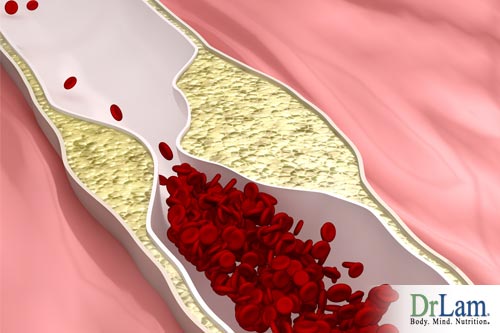 Over the past 40 years, our knowledge of the origin of atherosclerosis has increased exponentially. Could this be because of teh relationship between sugar and aging? Many studies have failed to show that a change in the amount of cholesterol in the diet had any significant effect on the incidence of heart disease. In fact, the correlation between diet cholesterol and serum cholesterol level is indeed weak. Furthermore, cholesterol is an important macronutrient necessary for hormonal synthesis and cell membrane stabilization. A low cholesterol level (below 150 mg/dl) has been linked with an increased cancer risk. Cholesterol in its natural form when made by the liver is an antioxidant and thus of great benefit to the body. It is only when oxidized cholesterol is eaten that the cholesterol becomes bad.
Over the past 40 years, our knowledge of the origin of atherosclerosis has increased exponentially. Could this be because of teh relationship between sugar and aging? Many studies have failed to show that a change in the amount of cholesterol in the diet had any significant effect on the incidence of heart disease. In fact, the correlation between diet cholesterol and serum cholesterol level is indeed weak. Furthermore, cholesterol is an important macronutrient necessary for hormonal synthesis and cell membrane stabilization. A low cholesterol level (below 150 mg/dl) has been linked with an increased cancer risk. Cholesterol in its natural form when made by the liver is an antioxidant and thus of great benefit to the body. It is only when oxidized cholesterol is eaten that the cholesterol becomes bad.
Based on false logic, it was believed that diets concentrating on lowering total serum cholesterol level would reduce coronary heart disease risks. This belief is valid if the cholesterol being lowered is LDL cholesterol only. Unfortunately, most popular low-fat, high-carbohydrate diets lower both HDL cholesterol as well as LDL cholesterol. No cardiovascular risk reduction is achieved as the LDL:HDL ratio remained constant. It must be remembered that cardiovascular risk is inversely related to HDL cholesterol level and directly proportional to LDL cholesterol level." In other words, the higher the HDL cholesterol, the lower the risk, and the higher the LDL cholesterol level, the higher the risk.
To make matters worse, such "low-fat, high carbohydrate" diets are often high in the wrong type of carbohydrates. Instead of taking in complex paleocarb type carbohydrates such as green leafy vegetables and whole grains, the less informed consumer often eats foods such as pasta, soda, processed foods, and fast foods. These types of food are rich in sugar and refined carbohydrates, which actually lower the important "good" HDL cholesterol, and as previously mentioned sugar and aging prematurely are related.
This is further complicated by the fact that consumers are often unclear as to what constitutes fat. There are different kinds of fat as there are different kinds of cholesterols. Monounsaturated fat such as olive oil is good. Natural unhydrogenated polyunsaturated fat, such as nuts and seeds, is good as well. Cold-water fish, such as salmon, for example, contain an abundance of this kind of fat with its active component omega-3 fatty acid, which is cardio protective. These two kinds of fats have been shown to reduce cardiovascular disease risk by 19 percent and 38 percent respectively in clinical studies.
Saturated fat is somewhat more complicated. It is derived from animal and dairy products that are commercially raised. Unfortunately, commercially raised animals, such as poultry, are laced with hormones, antibiotics, and are grain fed. They have higher levels of saturated fat in their meat. Saturated fat from this source has been linked to a 17 percent increase in cardiovascular disease risk in some studies. Saturated fats from free-range animals are the preferred way. The amounts of saturated fat in organic eggs, for example, are much lower than that in commercial eggs. What does this concept have to do with sugar and aging you might ask.
Well, the worse kind of fat is trans fat. This fat is produced when polyunsaturated vegetable fats are artificially hydrogenated, a process that increases the firmness of the oil and its resistance to oxidative damage. Trans fat is commonly used in cakes, donuts, fast foods, and fried foods. Trans fat has been linked to the highest risk of cardiovascular disease. Studies have shown that replacing 2 percent of energy eaten in the form of trans unsaturated fat with un-hydrogenated, unsaturated fat, such as nuts, olive oil, and flaxseed oil, drops heart disease risk by 53 percent.
 With each passing day, as the consumer becomes more educated, the mislead thinking that "fat and cholesterol-in-diet" equals to "fat and cholesterol-in-blood"? and therefore "fat and cholesterol-in-diet" equals to "cardiovascular disease" hypothesis is rapidly losing support. While the "death by dietary fat and cholesterol" hypothesis could be losing faith among advocates, the "death by dietary sugar" hypothesis is gaining ground as the world wakes up to the harmful effects of sugar.
With each passing day, as the consumer becomes more educated, the mislead thinking that "fat and cholesterol-in-diet" equals to "fat and cholesterol-in-blood"? and therefore "fat and cholesterol-in-diet" equals to "cardiovascular disease" hypothesis is rapidly losing support. While the "death by dietary fat and cholesterol" hypothesis could be losing faith among advocates, the "death by dietary sugar" hypothesis is gaining ground as the world wakes up to the harmful effects of sugar.
Clearly, cholesterol is not bad for you, and certain types of fat are healthy. Sugar, however, should be avoided as much as possible.
Sugar and aging: Simple refined carbohydrates are harmful to health and detrimental to anyone interested in anti-aging. In fact, the chances of you getting sick on a high sugar diet is far greater than if you smoke. An aggressive reduction in sugar intake is advisable if your family has a history of diabetes or cancer, or if you want to lead an anti-aging lifestyle. If you have to eat dessert, consume it during the day and not just before bedtime. Sugar, taken before bedtime, also reduces growth hormone release and increases cortisol, the "bad" hormone. Trying to restrict intake of foods such as sugar in coffee and bread is a good first step. After your body has detoxified by restricted sugar intake, you will feel lighter, and more energetic. Treat sugar as a drug - steer clear when possible.
A decreased sugar and aging reduction diet is encouraged by consuming refined carbohydrate intake as part of an overall anti-aging Mediterranean diet that focuses on three main pillars: reducing calories by 30 percent, increasing green leafy vegetable intake by 60 percent, reducing sugar intake by 90 percent.
Specifically, the consumption of lean meats (like wild game or non-grain fed, free-range domesticated animals), fish (such as cold water fish such like salmon which contains omega 3 fatty acids), vegetables, whole fruits, raw nuts and seeds, legumes, and whole grain cereal are recommended. Notably absent from this diet are dairy products, refined cereal, refined grains (neocarbs), trans fat (margarine and fried foods) and concentrated sweets. So sugar and aging prematurely are not as much of a worry in this particulare diet.
The consumption of sugar and aging in general are concerns that affect nearly all of us. An adherence to these dietary guidelines will not only address obesity but may also prove helpful in dietary-linked diseases such as diabetes, cancer, and cardiovascular illnesses and is one of the best kept anti-aging secrets.
